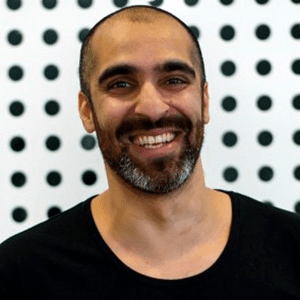

#42: Scaling your business for growth
For any CEO or business leader with ambitious growth plans, this is the podcast to listen to.
Adam Siegel, CEO and growth advisor at Visage Growth Partners, helps growth-focused leaders ease the pain with a holistic approach that clears the way for sustainable and profitable growth.
In this podcast, Adam unpacks the complexities for transforming and rapidly scaling a business using best practice business growth methodologies.
- How you get from where you are to where you want to be
- How to get your leadership team actively participating and contributing in this process, when they are focusing on the day-to-day challenges
- Structuring your team, the most effective way to get the results needed
- How you and your team can know your market
Adam also reveals the key attributes of a successful leader for business success; building capability and creating new levels of inspiration with an environment where questions are asked, and options are explored.
Stephanie: Welcome to TEC Live. Stephanie Christopher here, CEO of The Executive Connection. We connect leaders with a trusted network of people who help them succeed.
Leah: Stephanie, I know you’ve got an affection for Hawaii.
Stephanie: I have a deep affection for Hawaii.
Leah: So what do people say in Hawaii when they say, good afternoon?
Stephanie: A warmest aloha.
Leah: That’s really nice. I like that. Can I borrow it?
Stephanie: Yeah, you can indeed.
Leah: Okay, thanks.
Stephanie: And let me say a warmest aloha to Adam Siegel, our guest today on TEC Live. Adam is the CEO of Visage Growth Partners, a growth advisor to business owners and CEOs who helps them clear the way through the complexities of transforming and rapidly scaling their businesses. Adam Siegel, Welcome.
Adam: Thanks for having me.
Stephanie: It’s great to have you here. So let me unpack the complexities of your bio and see if we can get to the core of what you do with business owners. I’m a business owner and I have ambitious growth plans for my organisation. They’re really just quite a dream right now. How do I get from where I am to where I want to be?
Adam: How clearly does your team know about your dream?
Stephanie: Okay, so that’s a great first question. It’s all in my head. It’s a dream. It’s my dream. So tell me what I’m missing there.
Adam: So the key thing, it’s great that you got dreams. Many business owners and CEOs don’t actually, can’t articulate their dream. So if you’ve got it there and you’re pretty clear about it, you start to unpack it with your team and get it on paper. Ideally on one page.
Stephanie: A dream by its own nature is quite… So this is ambitious, this sort of vision that I have, hypothetically we’re talking right now. Isn’t it too early to bring the team in? And are they going to understand what I’m talking about?
Adam: They may not understand, but again, the idea is that you can articulate it in some way and create an environment where they can ask you questions and explore the options and what you’re trying to do and what you’re trying to say so that they can therefore help you put that in place. Your role is the chief vision officer fundamentally, and your executive team are responsible for helping you execute on your vision. So they’ll actually help you even pat out that vision and that dream into how it makes sense for the business to actually execute on it. It’s a really useful exercise.
Stephanie: Yeah. So what kind of things would I be doing in that exercise?
Adam: Well, I think first of all, you’re trying to take them on a bit of a journey about what your dream is about and really a dream is about taking something from where things are at right now and thinking about the possibilities of what might be based on some of the challenges that you can find them with right now, and maybe what the market’s doing around you and what the possibilities could be that you could take advantage of.
Stephanie: Yeah. You’ve said something about, you’ve said the challenges you’re facing right now, what the market’s doing around you and what the opportunities are fundamentally. So let’s pick up on those. So the challenges, assuming I have a leadership team, they’re going to be up to their eyeballs in the day-to-day challenges. How do I get them away from that to be thinking of my big ambition?
Adam: That’s a challenge, that’s a leadership challenge. How can you create some space and for them to have the desire to want to get in a room with you for, might be a half a day or a day, or sometimes two days to actually spend time focused on unpacking that dream and articulating that dream and the actions that are required from that. So it’s a commitment, it’s an investment in time for you and for them.
Stephanie: You can’t get around this. You have to take the time out to do this part of the process.
Adam: You could try, but it probably won’t work. It’s one of those things where you really need to spend time sharpening the saw effectively, that’s Stephen Covey, just to spend time and what you’ll find, not only will you unpack your dream with your team, but they’re going to start growing in their leadership capability. They will understand things or be exposed to things that they’ve never been exposed to before.
Stephanie: Yeah, like what?
Adam: Where you’re thinking strategically, you’re thinking about your business in the future, you’re thinking about the marketplace, you’re thinking about the possibilities, they’re probably typically fairly focused on their day-to-day or their month for the next quarter. So they’re not thinking like that, and in fact, they’re not really paid to do it, they’re paid to execute. Their focus is to execute. So it’s a meeting of the minds. So it’s opening them up to a new, I guess, a new focus.
Stephanie: Yeah. Okay. And so go back again. What kind of techniques would you use to get the leadership team to start to understand the bigger picture?
Adam: Well, there’s so many tools that you could use to unpack things in a very simplistic way. A SWOT analysis helps a business and a leadership team to understand strengths, weaknesses, opportunities, and threats confronting the business at that moment. That’s one very, very normal in the list of so many tools, Stephanie, you could look at. And typically when I work with businesses, it’s a one day activity just to understand where are we, right here right now.
Stephanie: Yep. And so I’ve got an example, say you’ve got five people in the leadership team and one of them is really dealing with challenging operational stuff. And they’re in that room for those two days, but they’re thinking, every time I leave this room and open my emails, I’m going to get slammed with 10 more things I have to deal with straight away. How can you get someone with probably so much to offer? How can you get them to really participate and contribute in that kind of conversation?
Adam: This is again, one of the biggest challenges and that’s a leadership issue. What you got me thinking about is this whole change management philosophy. And people won’t change unless you have three things and it’s a formula. D times V times P.
Stephanie: Say it again.
Adam: D times V times P.
Stephanie: D times V times P.
Adam: I’ll explain that to you.
Stephanie: Please.
Adam: D stands for dissatisfaction. The V stands for vision. And the P stands for plan. With that, and it’s a multiply, right?
Stephanie: Yeah.
Adam: So if any of those three is zero out of 10, the answer is zero. So in this case, you raise, unless that person accepts the fact that this situation is absolutely unsatisfactory, they won’t change. So, I’d be encouraging you to help them see how you’re not satisfied about their predicament of fighting fires over and over and over again. Unless they do something about it, nothing’s going to change. They’re going to keep on fighting fires. So on this, we’re just talking about getting them involved in a half-day or a one-day session with you away from their day-to-day business. So just helping them to understand that, unless we do something about it, nothing’s going to change and that’s the dissatisfaction. And part of it is, how can we help you create a vision for what success might be for you in your role? Imagine a day where you don’t have emails to respond to or fires to put out, or you can actually start thinking about the business and look at new technologies or a whole range of new things. So imagine if you could do that and start to inspire them. That’s the V part.
And then the plan is, well, I’ve got an idea. If we can get you in a room with your four colleagues, and we can have a real plan about how we get together, I’ve got a dream that I’d love to share with you, and I’d love you to contribute to, because you’re an expert a certain part of that business, you’re pivotal to be part of that plan. So I guess it’s just working through that little bit of a formula to help that person get inspired and understand that unless they do something different, they’re going to stay stuck.
Stephanie: I love that. I love the equation. How can you do this when you have various levels of engagement and capability then, in a leadership team?
Adam: I think it’s about setting new benchmarks, Stephanie.
Stephanie: All right. Okay, tell me what you mean.
Adam: I think it’s about creating a new level of inspiration for everyone. So they may be currently at different levels of capability, but sometimes they don’t know what they don’t know. And it’s quite amazing just looking at some of the businesses I work with. I sometimes encouraged the CEO to bring along a couple of people outside the executive team because it is a career advancement opportunity. And often that’s met with a little bit of resistance like, ‘Ah, they’re not strategic enough,’ or, ‘They’re not clued in enough,’ or whatever it is. But when you’re sitting in that room and you’re watching an up-and-comer, someone that’s really enthusiastic and really plugged in and really wants to contribute and you watch the lights go on with these people, they will very, very quickly grow in capability. So they’re the ones who can make it and can rise.
And then the other ones, basically, I think you have to, sometimes they won’t make it. Sometimes that person who is not at the capability you need is not the right person for that role. They may be a good soul, have a good fabric and you want to keep in the business, but in terms of taking the example you used before to meet the dream and your aspiration, they may not cut the mustard at this moment, but let’s find something else to do and find someone that can really step into that role with the capability that you need.
Stephanie: That you need. Am I hearing from you, Adam, that you’re working with the leadership team and just as much with the leader?
Adam: Yeah, so the way I work is I work one on one with the CEO, but the magic happens when you’ve got the CEO and the leadership team together. That’s when you start to get common language. So we do create a strategic plan on a page, but a common language, common focus, you get a synchronisation of resources and it’s built, fundamentally building leadership capability and everybody’s growing, there’s awakenings and awarenesses every session that we have. It’s some sort of leadership learning. And it’s interesting when I go around the room at the end of every session: What was the most useful thing for you from today from a leadership perspective? Everybody has a different perspective. So technically a room of six people, there’s six different learnings. And so whilst I might have my own learning, I’ve just heard five other opinions as well. And they’re all probably learnings as well. So it’s a great way to build capability.
Stephanie: Well, different perspectives always works. So what do you find as the biggest challenge leaders, CEOs, or founders have in embarking on a significant growth agenda?
Adam: Themselves.
Stephanie: Yeah, okay.
Adam: That’s probably the biggest challenge.
Stephanie: I figured you were going to say that. So tell me about it.
Adam: Well, I’m just thinking about a client I was with yesterday and I’ve been working… Very charismatic, highly capable, CEO and we just had our quarterly review with his team. So the review of the last quarter, planning to the next quarter, I’d been working really hard with him on creating space for his team to step into. And it was on zoom because they’re based in Singapore. As I was watching on zoom all day, he looked really uncomfortable. In fact, I thought he was upset and distracted about something. He’s message to me at the end of it was, they did really well. He said, ‘But I found it really challenging. I wondered whether I needed to be there.’
Stephanie: Wow, so that’s success in a way?
Adam: Huge success, but he was kind of grieving. I explained to him that most CEOs who go through this transition where they step back and they let people in, they’re letting go of the control that they love and crave and many say it’s great in many things in their business, but they can’t scale if they didn’t keep on holding onto those things all the time. He was a great example of that. I asked him, my followup question to him was yesterday, the outcomes that we got. So the five priorities for the business for the next quarter. Were they any different from what you would’ve thought they would’ve been if you had impressed yourself upon the meeting, like you typically did? He said, ‘No, they weren’t. They were exactly the same.’ So I said, ‘Bingo, you’ve won.’
Stephanie: But the team owns them.
Adam: Correct. It’s a much better outcome than when you impress yourself and impose yourself on your team and let that be a lesson and an inspiration to yourself for the next meeting you go with them. To trust that you actually have got a great team, that if you leverage their capability, you’re going to grow this business significantly. And this business has grown 25% a year in the last three years, after being stagnant for six years.
Stephanie: Wow. Well, that’s magic.
Adam: Magic.
Stephanie: What other examples?
Adam: That’s a pretty good one.
Stephanie: No, that’s a very good one. Now I want a better one. That was a very good one.
Adam: I think fundamentally, so I’m just going to go to the question, Stephanie, which was what are the biggest challenges? And I did say themselves. I think that is the essence. And it’s about letting go and letting go of control. I think once businesses have been successful for a period of time, it’s about how they remain, I guess, contemporary. How they remain ahead of the curve. And that kind of, I’m thinking about strategy at the moment. So to what extent is their strategy differentiated from their nearest competitors? Because if it’s the same, they’re not going to exceed and grow the way they could. So that’s one element.
The other element of it is how valuable is what they’re doing from a goods and/or services perspective to their customers. So a strategy has to be differentiated, so unique, and it has to be valuable in the eyes of the customer. So I’m thinking that’s a big challenge and to be both differentiated and unique, you’ve got to stay across, first of all, what are my competitors doing? And the second thing is, what are my customers doing? What do they need? And in the last year, needs of customers have shifted dramatically.
Stephanie: Dramatically and quickly.
Adam: Quickly, some have bounced back to the way it was and some have bounced back partially. So again, many people have pivoted their businesses. Well, does the pivot still work? Will it still work or is there a new pivot that’s required? So I think it’s about staying on top of that and what I’m hearing, not enough of across businesses that I see that I work with and the businesses that I’m observing, they do not know their customer well enough, nor do they understand their competitors. And then that the competitive piece, it’s not about obsessing about your competitors, but it’s about at least having some benchmarking across what they’re doing. What are their plans? What are they doing in the marketplace? Where are they winning and where are they not? And it’s about having some sort of line or some sort of view on that.
Stephanie: How important is it also to have an eye on new competitors coming in?
Adam: Very important. And I think that’s about knowing your business. Knowing your business is about knowing your customer, knowing your competitors and knowing your marketplace. You need to be across all those sorts of things. So looking at the political environment, your marketplace and the social impacts and the economic impacts, the environmental impacts. You need to, a CEO and their leadership team need to avail themselves of all the information across those types of areas all the time.
Stephanie: How well do you find in general, CEOs and leadership teams know their market?
Adam: Again, the ones that I work with intimately when we start, they are really across that stuff. But it becomes part of their routine and their quarterly routine and rhythm have to do it. And things don’t necessarily change that dramatically, but I’d rather be there at the quarter to know when something does change. And I’ve seen examples of that, where and coming into COVID and then out of… Into COVID in particular, because we were aware, we got very quickly onto that, we could see some of the changes had to happen. That’s a great example, but often markets move, technology comes in.
Stephanie: And is the approach that you’re talking about relevant for all sorts of industries or is this professional services, mainly?
Adam: I work with so many types of industries and business. I can’t think of one that this would not apply to.
Stephanie: Yeah, right. Okay. What’s been the biggest challenge for businesses actually coming out of COVID, at this point, a full 12 months? Yeah, what’s been the biggest challenge? Not going in because that’s somewhat old news and we all lived in that. Thank God, it’s a year ago. What has been the biggest challenges for businesses coming out?
Adam: There’s been a big shift in culture, and I’m going to share another story of a client that’s really grappling with the return to work situation.
Stephanie: So return mto the office. I assume people have been working for a year…
Adam: They have been working they were phoned that, return to the office, and it’s been really problematic with this company in particular. There’ve been some people said, ‘We are so comfortable at home, we are so productive.’ And the directors are like, ‘No, it’s not productive.’ There’s been some real challenges to say that. So, that’s one thing that’s been a big challenge. So the culture. Can you create and sustain a culture in a remote environment? It’s definitely harder.
Stephanie: Well, I would point the listeners to our podcast with Maja Paleka about flexibility and what the future of work looks like now compared with a year ago. So yes, culture, what else?
Adam: So, that’s one. The other piece is, and I was with 40 CEOs last week, actually, and 20 of them at least spoke about talent as being the biggest challenge. And they were all looking for people to fill roles and it was kind of like,
Stephanie: Because they’re growing, or they’re changing up their people?
Adam: There was a growth appetite in the room.
Stephanie: Yeah, I’m saying that too. It’s just-
Adam: That’s part of it. I think people have also had a chance to really reflect on their staff and their capability of the staff. Can I take us to where we want to go? And on the other side of the same coin, the staff are saying, ‘Do I really want to be part of this business?’ Because it’s been a tectonic shift for everybody. So I think we’ve got a dynamic happening on both sides. So, that was a really huge challenge that I heard staff. And it was interesting because people were talking about, we need to find a body to put into this position. And I’m like, well, that’s a very small part of the challenge. It’s finding the right body to put it into-
Stephanie: The right person, in the right position.
Adam: Correct. So again, there’s so many organisations again, with the move and changes in the economy, are they structured in the right way, the most effective way to get the results they need? Often than not. Because, again, one of the biggest challenges is, who is accountable for what in organisations? When I ask people within a business in a leadership team who is accountable for certain functions, I can get four or five names for one function. Which means if there’s more than one person accountable,
Stephanie: It’s shared and it’s not going to happen.
Adam: No one’s accountable. So, that’s a big challenge as well. So, this people piece, this talent piece is critical, a challenge as well.
Stephanie: Yeah, it is. It is. I’m hearing a lot about that right now. So as a leader, thinking about the leader with the criticality of bringing your own team with you, of giving them space, I love that, of giving them space to fill what are the key attributes of a leader who’s going to be successful in achieving their dream?
Adam: Humble.
Stephanie: Humble.
Adam: That would be the first one and the most important one. So it’s an ability to see things the way they really are, not through their own lenses or lens, but the way they really are. And that says, first of all, I don’t have all the answers myself, I have a team around me that are geniuses, and I’m going to really try and tap into that as much as I can. And I think it’s a resolve and a conviction that as a leader, I don’t have all the answers.
Stephanie: Humble isn’t self-deprecating though, is it?
Adam: Not at all.
Stephanie: It’s not saying, ‘Oh no, no, no. I’m no good at that. I couldn’t do that.’ When it’s something that actually, you may be the best at.
Adam: No, not at all. No, it’s a genuine belief that there are people and resources out there greater than I am in certain things. And it’s about, but also seeing what you’re good at. So when someone compliments you, that you can say thank you, and you actually feel it like, yeah, I am good at that.
Stephanie: That’s my thing. Okay, humble. Great, what else?
Adam: I’m going to lean on Patrick Lencioni.
Stephanie: I know, I guess I know what’s coming.
Adam: What’s the next one?
Stephanie: Hungry.
Adam: Hungry, absolutely. So again, it’s that leader that is hungry, that sees opportunities and seizes the opportunities, that knows there’s more and looking for better ways, new ways either to inspire people or to execute or create a strategy, a whole range of things. There’s a drive and sometimes there’s an economic outcome there, but I think the hunger is around a purpose far greater than themselves.
Stephanie: Yes.
Adam: That’s where the hunger becomes really, really powerful. I’ve seen CEOs who are hungry for themselves. Well, that’s kind of, that defeats the humility piece too, right?
Stephanie: Yeah.
Adam: So, that hunger has to be on greater-
Stephanie: Far greater purpose.
Adam: Absolutely.
Stephanie: And what’s the third one, Adam?
Adam: Smart.
Stephanie: Smart. What kind of smart?
Adam: So, it’s not intelligence in IQ, it’s about the way they link with their people, understanding people. So, it’s emotional intelligence, fundamentally. So they’re the three key attributes of leaders. There are some others. I mentioned before, we’re talking about vision. I think a leader has to be able to, and this is a real challenge for most somehow think conceptually, long-term strategically and conceptually about possibilities, almost a dreamer. And they may not be dreamers and I’m not one of the dreamers, but I think if I research and I have an appetite for things like that, then they’re going to explore and it helps them paint a picture of what are the possibilities.
Stephanie: Fantastic, you’ve created a dream or a picture of what this could be. So it’s the leader who is humble, hungry, and smart. It’s the leader who recognises that there’s so much that their leadership team and then ultimately the whole organisation, can deliver and imparts that the leader can’t themselves, that they take the time out to work on the business, not in the business and encourage in fact, expect that of their leadership team. And it’s coming up with a plan that may well… Well, it needs to have long-term ambition, but then it’s also something that can be rolled out quarterly, and in fact, for the first year as well, you’ve created a really good picture and you’ve made it sound possible. Thank you for your thoughtful consideration, loved your examples and Adam Siegel, lovely to have you. Thank you very much. Thanks Stephanie. Thanks for having me. Discover more about TEC.



